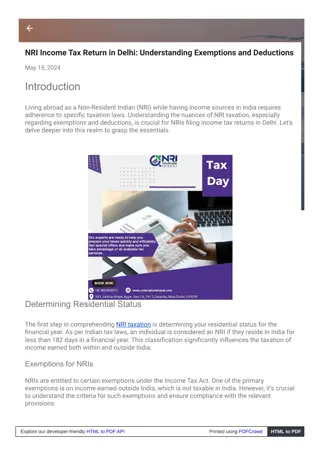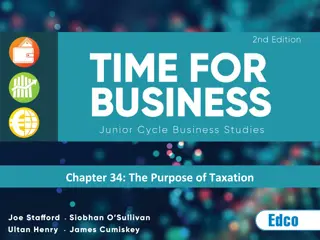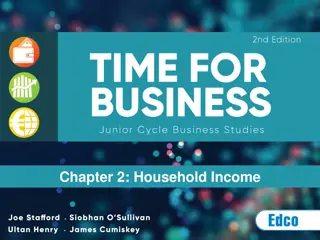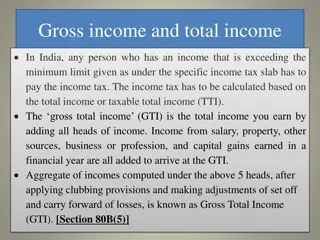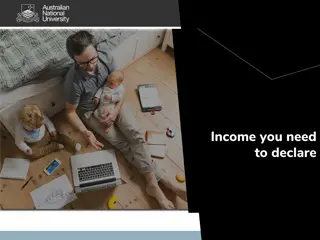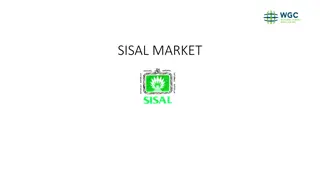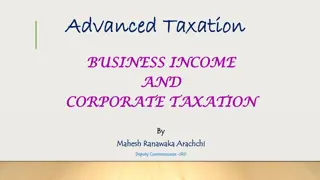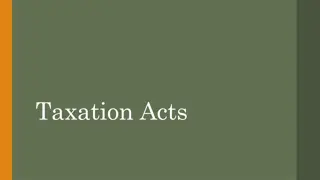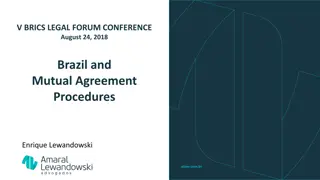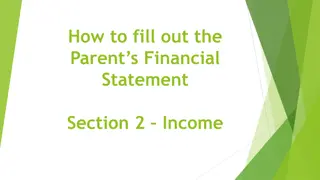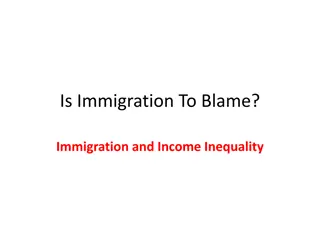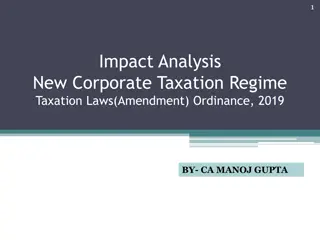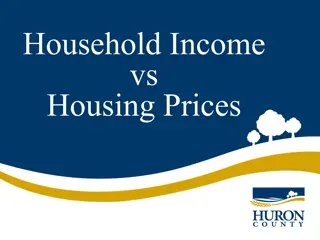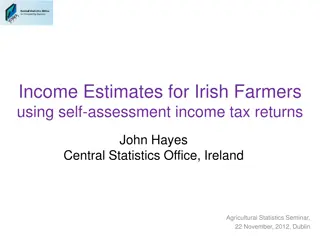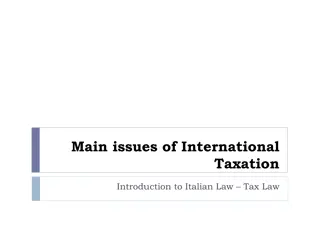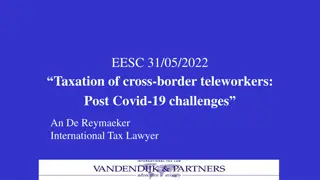Brazil's Taxation Impact on Household Income Distribution
This study investigates the effects of Brazil's high taxation and social spending on the distribution of household income, focusing on programs like Bolsa Família and direct transfers. The research explores income concepts, data sources, and the impact of various transfer programs on poverty and inequality in Brazil.
Download Presentation

Please find below an Image/Link to download the presentation.
The content on the website is provided AS IS for your information and personal use only. It may not be sold, licensed, or shared on other websites without obtaining consent from the author.If you encounter any issues during the download, it is possible that the publisher has removed the file from their server.
You are allowed to download the files provided on this website for personal or commercial use, subject to the condition that they are used lawfully. All files are the property of their respective owners.
The content on the website is provided AS IS for your information and personal use only. It may not be sold, licensed, or shared on other websites without obtaining consent from the author.
E N D
Presentation Transcript
The Effects of Brazils High Taxation and Social Spending on the Distribution of Household Income Sean Higgins and Claudiney Pereira Department of Economics Tulane University LASA 2013, Washington, DC May 31, 2013
Introduction Inequality and poverty in Brazil Other studies Immervoll et al. (2009) Nogueira et al. (2011) Silveira et al. (2011) Souza and Souza (2012) Our contribution: Most comprehensive study to date: Transfers Subsidies Indirect Comparable methodology (CEQ)
Data POF 2008-20009 Labor income Direct taxes Use of public education Consumption Health PNAD 2008 National accounts Revenue Spending
Direct Transfers Bolsa Fam lia Conditional cash transfer program for the poor Health and education conditions 41.2 million individuals in beneficiary families in 2009 (MDS 2011) Average benefit per person living in a beneficiary household: $0.35 PPP per day BPC Non-contributory pension for elderly poor 3.2 million beneficiaries in 2009 (SAGI/MDS 2012) Average benefit per person living in a beneficiary household: $2.18 PPP per day
Direct Transfers (continued) Unemployment insurance Require working continuously for six months prior to layoff 8 million beneficiaries in 2009 (Minist rio do Trabalho 2011) Average benefit per person living in a beneficiary household: $0.74 PPP per day Special circumstances pensions Part of contributory system but considered non- contributory because of low or no contribution requirements and means-testing 2.9 million beneficiaries in 2009 (INSS 2011) Average benefit per person living in a beneficiary household : $5.22 PPP per day
Direct Transfers (continued) Milk transfers (PAA Leite) Largest food transfer program in Brazil Provides milk to low-income households with child, pregnant woman, or elderly In Northeast region and part of Minas Gerais state Eligible households receive one or two free liters of milk per day Other direct transfers Minimum income programs (state and municipal) Government aux lios Basic food basket program
Targeted Energy Subsidies Social Tariff on Electric Energy (TSEE) Price subsidy for low income households with total energy consumption below 220 kilowatt hours per month Discount ranges from 10% to 65% Average benefit per person in a beneficiary household: $0.36 PPP per day
In-Kind Benefits Public education Free at all levels including pre-school and tertiary Public health care No national health insurance system Unified Health System (SUS) guarantees free and unlimited access to care at public health facilities Part of 1988 Constitution
Taxes 35% of GDP Direct taxes are 45% of total, indirect 55% High exemption threshold and large informal sector less than 10% of economically active pay individual income tax Many indirect taxes ICMS, IPI, PIS, COFINS, Cascading effect
Methodology: Direct Taxes Direct identification method except FGTS (payroll taxes) FGTS: simulation method Lack formal sector variable; assumed all workers who made other contributions on their labor income also paid FGTS Since paid by employer, created pre-FGTS counterfactual labor income assuming burden of tax borne fully by labor
Methodology: Direct Transfers Direct identification from survey Bolsa Fam lia Discrepancy between total beneficiary households in national accounts (12.1 million) and survey (7.3) Use propensity score matching method (Souza, Os rio, and Soares 2011) to impute benefits to very similar households who did not report receiving benefits Milk transfers (PAA Leite) Assumed milk consumed with the form of purchase reported as donation by households in eligible states came from the program
Methodology: Energy Subsidies Lack data on consumption in kilowatt hours (kWh) which determines program eligibility Have (post-tax) energy consumption in R$/month Collect data on (pre-tax) prices for all Brazilian energy companies and within each state, average across companies in that state Combine with tax code for electricity in that state and with subsidy rates to determine consumption in kWh Calculate benefit Spending for household s consumption in kWh at market rates minus actual spending
Methodology: Indirect Taxes ICMS and IPI Group consumption goods into nine categories Apply effective tax rates for these categories calculated by Nogueira et al. (2011) Uses input-output matrix Accounts for evasion PIS and COFINS Apply effective tax rates by decile calculated by Rezende and Afonso (2010)
Methodology: Health Benefits Alternate survey (PNAD 2008 health supplement) Group types of health services reported in PNAD into 3 aggregate categories Primary care In-patient care Preventative care From administrative data, calculate average per-visit spending by state and by type of care Impute this benefit to individuals in that state who received that type of care from a public facility
Results Market income is very unequal in Brazil Market Income Gini = 0.58 Absolute inequality reduction is impressive by Latin American (but not EU/US/OECD) standards Nevertheless, spending is high and effectiveness is low
Results Most progressive programs (Bolsa Fam lia, BPC, milk transfers) are small In terms of budget share (each <0.6% of GDP) And in terms of average benefit per beneficiary Indirect taxes offset the poverty-reducing benefits of direct transfers and indirect subsidies Post-fiscal income poverty is higher than market income poverty for some poverty lines
Future work (in progress) Urban x rural inequality Racial/Ethnic inequality
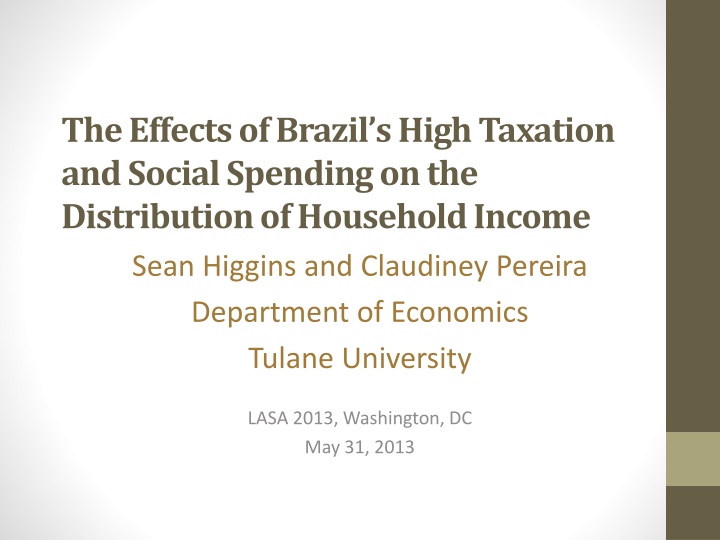

![Halal_Chicken_from_Brazil-_Ensuring_Quality_and_Authenticity[1]](/thumb/86918/halal-chicken-from-brazil-ensuring-quality-and-authenticity-1.jpg)
